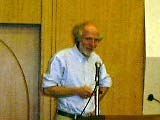Heparan sulphate (HS) is a complex linear polysaccharide found
mainly in association with cell surfaces and the pericellular matrix.
It is normally present as a component of proteoglycans (PGs) and the core
proteins of the HSPGs largely determine the cell and tissue distribution.
One of the major functions of HS is to act as a co-receptor for a variety
of growth factors and cytokines; it also plays key roles in other processes
unrelated to cell growth such as the control of blood coagulation and
the regulation of lipid metabolism. HS is also an important molecule in
the control of cell adhesion. This functional diversity of HS arises because
of its capacity for specific protein recognition with consequent modulation
of activity of the interacting proteins. The most extensively documented
example of this is the activation of antithrombin by a rare pentasaccharide
sequence present in HS and in the chemically related therapeutic heparins.
Other examples of binding specificity or selectivity include interactions
with basic fibroblast growth factor (bFGF), hepatocyte growth factor,
fibronectin and cytokines such as interferon λ, platelet factor 4 and
IL-8.
Implicit in the realization of this extensive functional repertoire of
HS is the presence of distinct intra-chain sequences or conformations
that support the range of required protein interactions. This appears
to be achieved by the unique molecular design of HS in which the sulphated
sugar residues are clustered in a series of domains, called S-domains,
of variable length and sulphation pattern separated by regions of low
sulphation and relatively uniform structure. Information for protein recognition
is present mainly within the hypervariable S-domains and, in the cases
of multimeric proteins (eg. platelet factor 4) the spacing of these domains
along The polymer chain. New approaches to the sequence analysis of the
S-domains in HS will be described and ideas about how HS regulates cell
proliferation will be discussed in relation to growth factors such as
bFGF and VEGF that act on vascular cells.
|
![]()

![]()